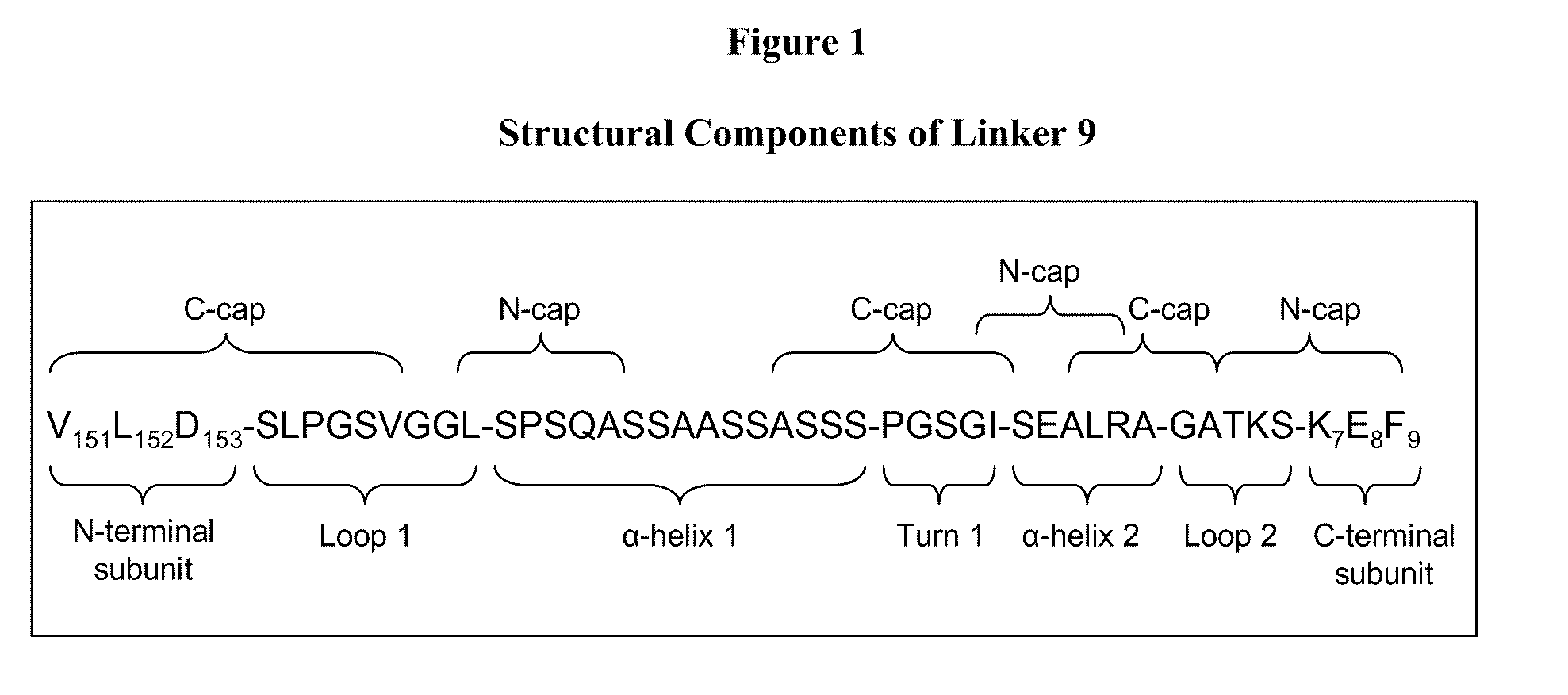Rationally-designed single-chain meganucleases with non-palindromic recognition sequences
a single-chain, non-palindromic technology, applied in the field of molecular biology and recombinant nucleic acid technology, can solve the problems of residual non-specific cleavage activity, high mutagenic and toxic, and inability to target gene modifications to unique sites within a chromosomal background
- Summary
- Abstract
- Description
- Claims
- Application Information
AI Technical Summary
Benefits of technology
Problems solved by technology
Method used
Image
Examples
example 1
Evaluation of the Method of Epinat et al
1. Single Chain Meganucleases Using the Method of Epinat et al.
[0138]Epinat et al. (2003), Nucleic Acids Res. 31: 2952-62 and WO 2003 / 078619 report the production of a single-chain meganuclease derived from the I-CreI meganuclease. Specifically, the authors used an 11 amino acid peptide linker derived from I-DmoI (amino acids 94-104 of I-DmoI, sequence MLERIRLFNMR) to join an N-terminal I-CreI subunit (amino acids 1-93 of I-CreI) to a C-terminal I-CreI subunit (amino acids 8-163). This particular arrangement of N-terminal subunit—linker—C-terminal subunit was selected because it most closely mimics the domain organization of the di-LAGLIDADG I-DmoI meganuclease. The authors evaluated the single-chain I-CreI meganuclease experimentally and found it to cleave a wild-type I-CreI recognition sequence effectively, albeit at a significantly reduced rate relative to the wild-type I-CreI homodimer.
[0139]Because the fusion protein produced by these aut...
example 2
Single-Chain I-CreI Meganucleases Produced Using a Flexible Gly-Ser Linker
1. Design of Single-Chain LAM Meganucleases Using a Gly-Ser Linker
[0146]The designed LAM1 and LAM2 endonucleases were fused into a single polypeptide using Linker 3 from Table 3. Val-151 was used as the N-terminal fusion point (to the LAM1 subunit) while Phe-9 was the C-terminal fusion point (to the LAM2 subunit). The resulting single-chain meganuclease, “LAM1gsLAM2” (SEQ ID NO: 50) was cloned into pET21a, expressed in E. coli and purified as described in Example 1.
2. Results
[0147]LAM1gsLAM2 was assayed for cleavage activity using the same DNA substrates and incubation conditions as described in Example 1. In contrast to results with the LAMep meganucleases, LAM was found to cleave primarily the hybrid LAM1 / LAM2 recognition sequence (SEQ ID NOs: 46 and 47). The extent of cleavage is significantly reduced relative to the LAM1 / LAM2 heterodimer produced by co-expressing the LAM1 and LAM2 monomers in E. coli. Unde...
example 3
Single-Chain I-CreI Meganucleases Produced Using a Structured Linker
[0148]1. Design of single-chain LAM meganucleases using a designed, structured linker
[0149]The designed LAM1 and LAM2 endonucleases were fused into a single polypeptide using Linker 9 from Table 6. Asp-153 was used as the N-terminal fusion point (to the LAM1 subunit) while Lys-7 was the C-terminal fusion point (to the LAM2 subunit). The resulting single-chain meganuclease, “LAM1desLAM2” (SEQ ID NO: 51) was cloned into pET21a, expressed in E. coli and purified as described in Example 1.
2. Results
[0150]LAM1desLAM2 was assayed for cleavage activity using the same DNA substrates and incubation conditions as described in Example 1. In contrast to results with the LAMep meganucleases, LAM1desLAM2 was found to cleave primarily the hybrid LAM1 / LAM2 recognition sequence (SEQ ID NO: 46 and 47). The extent of cleavage is comparable to the LAM1 / LAM2 heterodimer produced by co-expressing the LAM1 and LAM2 monomers in E. coli. Th...
PUM
| Property | Measurement | Unit |
|---|---|---|
| Fraction | aaaaa | aaaaa |
| Fraction | aaaaa | aaaaa |
| Mass | aaaaa | aaaaa |
Abstract
Description
Claims
Application Information
 Login to View More
Login to View More - R&D
- Intellectual Property
- Life Sciences
- Materials
- Tech Scout
- Unparalleled Data Quality
- Higher Quality Content
- 60% Fewer Hallucinations
Browse by: Latest US Patents, China's latest patents, Technical Efficacy Thesaurus, Application Domain, Technology Topic, Popular Technical Reports.
© 2025 PatSnap. All rights reserved.Legal|Privacy policy|Modern Slavery Act Transparency Statement|Sitemap|About US| Contact US: help@patsnap.com


